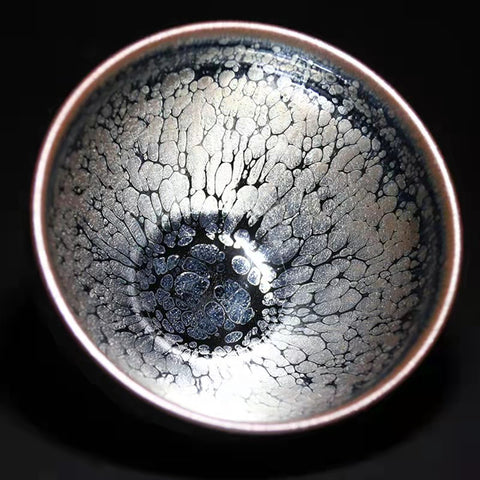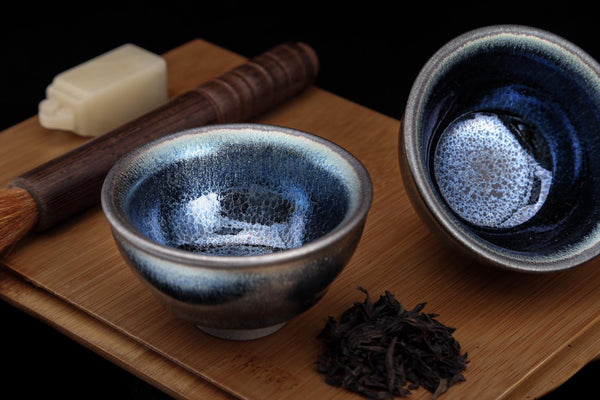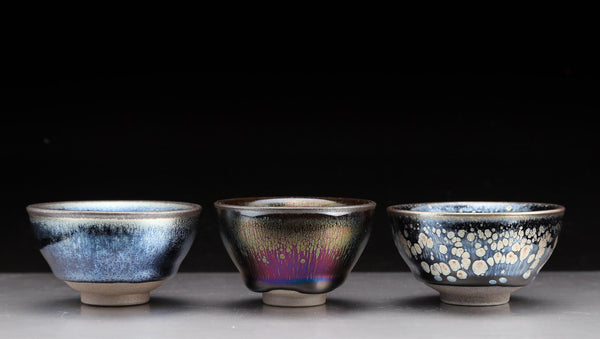THE RECORD OF TEA STATES: "IF YOU WISH TO WHISK TEA, YOU MUST FIRST WARM THE BOWL. IF IT IS COLD, THE TEA WILL NOT FLOAT. THE BODY OF THE RABBIT'S FUR BOWLS IS THICK, SO THEY RETAIN HEAT FOR A LONG TIME AND ARE VERY SUITABLE FOR USE."
Jian Zhan pottery is the perfection of Chinese black porcelain. It was an inseparable part of tea culture in the Song Dynasty, however, it slowly gave way to Yixing teaware. It continued to prosper in Japan, where it is known as Tenmoku. Nowadays, it is a national treasure in Japan and many local pottery artists in China are hard at work to remake this once forgotten part of the Chinese tea ceremony. Jian ware is not only teaware, it is an art form and an important part of history. One we can get lost in for hours just by looking at its cosmic-like glaze.
THE HISTORY OF TENMOKU POTTERY
Jian ware (also known as Jian Zhan or Tian Mu Porcelain) is a type of Chinese black porcelain originating from Jianyang, Fujian province.
Pottery has existed in Fujian province since the time of the Northern and Southern Dynasties (220–589). However, the Jian Zhan tea cup saw its rise during the Song Dynasty (960 - 1279). Nowadays, it is revered as the pinnacle of black porcelain ware.
At the time, tea was a big part of Chinese culture and lifestyle, although it was drunk in a very particular way. Tea was compressed into bricks, ground up into a powder, and whisked in tea bowls, much like present-day Japanese matcha green tea.
Once the green powder was whisked against the brilliant black, blue, and purple hues of Tian Mu bowls, it created an exquisite contrast. Against the dark glaze, it was exceptionally pleasing to look at the green foam. It was proclaimed that this teaware is the only true way tea should be enjoyed!
In the Song Dynasty's "The Record of Tea" it was said about Jian Zhan:
"Tea is of light color and looks best in black cups. The cups made at Jianyang are bluish-black, marked like the fur of a hare. Being of rather thick fabric, they retain the heat so that when once warmed through, they cool very slowly, and they are additionally valued on this account. None of the cups produced at other places can rival these. Blue and white cups are not used by those who give tea-tasting parties."
In 1335, during the Kamakura period, a Japanese monk who was practicing in China brought back a Jian tea cup with him. In Japan, the style started to be known as Tenmoku, which is the Japanese way to say Tian Mu.

The style of teaware quickly became a national favorite in Japan, where the Japanese tea ceremony, Chanoyu, was slowly at its rise. The beautiful vibrancy of freshly ground matcha powder complimented the bowls greatly. Since then, the techniques of making tenmoku glazed chawan (tea bowls) were passed on through generations to this day.
Unfortunately, this was not the case in China. Following the Song Dynasty, the elite switched to favor loose leaf tea. Loose leaf tea required steeping in teapots, thus Yixing ware became the teaware of choice. Since that era forward Yixing ware continued flourishing in China while Jian Zhan became all but abandoned.
Since the 1900s, there has been a wave of potters in China dedicated to reviving this beautiful old part of Chinese culture. Under the guidance of some revered Japanese tenmoku potters, they have been reclaiming the style, rebuilding old kins, as well as making new ones.
Although presently there are still only a few Chinese potters who have mastered the style, we can enjoy tea in the once treasured Jian Zhan tea bowls, savoring all their benefits.
JIAN TEA CUP MAKING
A Jianzhan teacup is known for its simple shape, yet heaviness and sturdiness, which feels very pleasant in the hands. The style is characterized by the subtle effects in the glazes. These can only be achieved with a high-iron glaze and high firing temperatures, using special kilns. These patterns are characterized as follows: rabbit's hair, oil drop, and partridge feathers.
The clay used for Jian pottery is very high in iron and requires a very high temperature for firing. Kilns used for firing this style of teaware are not easy to make and thus are incredibly precious.
Building an appropriate kiln is only a part of the struggles that Jian Zhan potters face. Only with the right kiln can the glaze run so beautifully, creating the iconic patterns of this pottery style, and thickening at the bottom of the tea cup's foot.
The parts of the process most worth noting are:
-
Propper clay
Propper clay is one of the most crucial elements of Jian ware. The clay found in Fujian province extremely high in iron content, much more so than clay in any other region. Many have tried to replicate Jian ware with local clay from their regions, all to no avail. -
Shape the bowl
Jian Zhan pottery is most commonly made on potters wheels. The shapes are quite simple. A wide, round bowl with a slightly high foot, allowing for the glaze to gracefully drip without sticking to the bottom of the kiln. -
Special glaze
The glaze for Jian ware must be hand-made. It is not a simple task getting the glaze recipe correct, and many potters spend years experimenting until they finally have the right recipe.
To make the glaze for Jian zhan pottery, an iron-rich glaze is mixed with plant ash. -
Precise glazing
Glazing is yet another delicate task. The bowl has to be glazed skillfully and with balance. If the glaze is too thick, it will run and stick to the kiln's bottom. If too thin, it will not produce beautiful galactic colors and unique patterns. -
Firing the glazed pottery
Perhaps this is the most challenging step of making beautiful Jian ware. Not only does the special kiln have to be built precisely, but the potter must meticulously control the time and temperature. Getting the right temperature/time ratio is also a process that requires countless experiments.
Finally, once the kiln has been fired and is ready to open, only a fraction of the Jian ware is suitable for sale.
Interestingly enough, all Jian ware is made and glazed equally. The differences in the final patterns will depend on the firing temperatures, time, and position in the kiln.
WHAT ARE THE HEALTH BENEFITS OF DRINKING TEA FROM JIAN WARE?
When we think of the health benefits of drinking tea, we rarely consider the tea utensils to be a part of those benefits. In fact, it is all the components of tea which make it good for our health.
There is a Chinese saying: "Water is the mother of tea and teaware is the father of tea."
They are indeed, inseparable.
The high iron content of Jian ware improves the alkalinity of the tea water. We all know that drinking water that is high in alkalinity is beneficial for our health. However, it is also good for the tea itself. Your freshly brewed tea will become smoother and more aromatic.
You could try a small experiment at home to see the benefits first-hand. Brew the same tea and pour some in both a Jian Zhan tea cup and a regular porcelain teacup. Sip them side by side and notice the difference of taste, mouthfeel, and aroma.
Afterward, you can try leaving some tea in both teacups untouched for about half a day. Sip them and notice the difference. People usually report that the tea in the Jian teacup will taste fresh. At the same time, the other cup will develop some bitterness. This is just another way of testing the potent mineral qualities of the teacup glaze.
When drinking tea from a Jianzhan teacup, the temperature of the brew will stay warm for a long time, yet without burning you. Sipping the tea, watch the colors of the glaze gently intermingle with the brew. The dark yet vibrant colors of the iron-rich glaze will unite. Forming beautiful gold, blues, and other magical colors.
Reference:“All about the Jian Zhan”,Angelina Kurganska,

